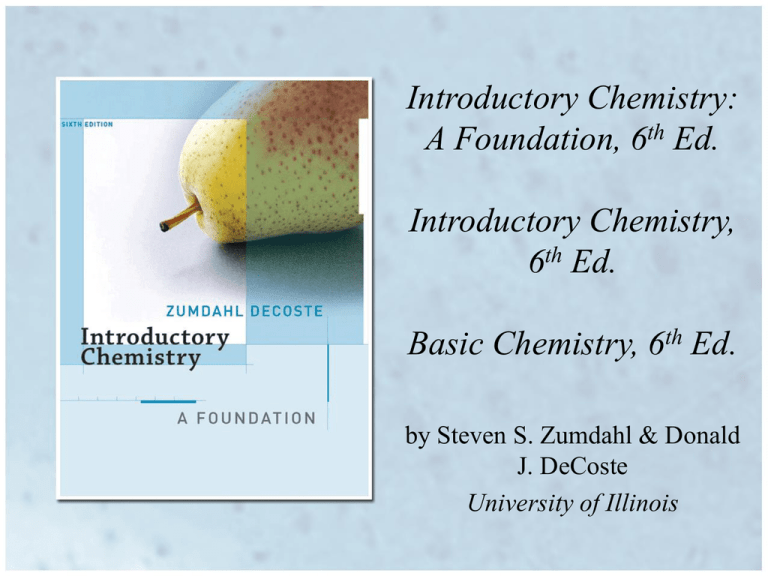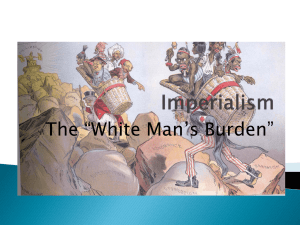
Introductory Chemistry:
A Foundation, 6th Ed.
Introductory Chemistry,
6th Ed.
Basic Chemistry, 6th Ed.
by Steven S. Zumdahl & Donald
J. DeCoste
University of Illinois
Chapter 13
Gases
Properties of Gases
• Expand to completely fill their container
• Take the shape of their container
• Low density
– Much less than solid or liquid state
• Compressible
• Mixtures of gases are always homogeneous
• Fluid
Copyright © Houghton Mifflin Company. All rights reserved.
13 | 3
Gas Pressure
• Pressure = total force applied to a certain area
– Larger force = larger pressure
– Smaller area = larger pressure
• Gas pressure caused by gas molecules colliding
with container or surface
• More forceful or more frequent collisions mean
higher gas pressure
Copyright © Houghton Mifflin Company. All rights reserved.
13 | 4
Air Pressure
• Constantly present when air present
• Decreases with altitude
– Less air = less pressure
• Varies with weather conditions
Copyright © Houghton Mifflin Company. All rights reserved.
13 | 5
Air Pressure (cont.)
• Measured using a barometer
– Column of mercury supported by air pressure
– Longer mercury column supported = higher
pressure
– Force of the air on the surface of the mercury
balanced by the pull of gravity on the column of
mercury
Copyright © Houghton Mifflin Company. All rights reserved.
13 | 6
Measuring Pressure of a Trapped Gas
Copyright © Houghton Mifflin Company. All rights reserved.
13 | 7
Measuring Pressure of a Trapped Gas
(cont.)
Copyright © Houghton Mifflin Company. All rights reserved.
13 | 8
Units of Gas Pressure
• Atmosphere (atm)
• Height of a column of mercury (mm Hg,
in Hg)
• Torr
• Pascal (Pa)
• Pounds per square inch (psi, lbs/in2)
• 1.000 atm = 760.0 mm Hg = 29.92 in Hg =
760.0 torr = 101,325 Pa = 101.325 kPa =
14.69 psi
Copyright © Houghton Mifflin Company. All rights reserved.
13 | 9
Self check p 390
• On a summer day in Colorado, the atmospheric
pressure is 525 mm Hg. What is this air
pressure in atmospheres?
• P418• Q7. Convert the following into atmospheres• 109.2 kPa, 781 torr, 781 mm Hg, 15.2 psi
• Q9. Convert the following into mm Hg
• 822 torr, 121.4 kPa, 1.14 atm,
9.75psi
Copyright © Houghton Mifflin Company. All rights reserved.
13 | 10
Boyle’s Law
• Pressure is inversely proportional to volume
– Constant T and amount of gas
• As P increases, V decreases by the same
factor.
• P x V = constant
• P1 x V1 = P2 x V2
Copyright © Houghton Mifflin Company. All rights reserved.
13 | 11
Boyle’s Law (cont.)
Copyright © Houghton Mifflin Company. All rights reserved.
13 | 12
Boyle’s Law (cont.)
Copyright © Houghton Mifflin Company. All rights reserved.
13 | 13
Example:
What is the new volume if a 1.5 L sample of
Freon-12 at 56 torr is compressed to 150 torr?
Copyright © Houghton Mifflin Company. All rights reserved.
13 | 14
Example (cont.)
• Choose the correct gas law:
Since we are looking at the relationship
between pressure and volume we use Boyle’s
Law.
P1 x V1 = P2 x V2
• Solve equation for the unknown variable:
P1 x V1 P2 x V2
P1
x V1 V2
P2
Copyright © Houghton Mifflin Company. All rights reserved.
13 | 15
Example (cont.)
• Plug in the known values and calculate the
unknown:
P1 = 56 torr
V1 = 1.5 L
P2 = 150 torr
V2 = ? L
P1
x V 1 V2
P2
56 t orr
x 1.5 L 0.56L
150 t orr
Copyright © Houghton Mifflin Company. All rights reserved.
13 | 16
Self check p 394
• A sample of neon to be used in a sign has a
volume of 1.51 L at a pressure of 635 torr.
Calculate the volume of a gas after it is
pumped into the glass tubes of the signs where
it shows a pressure of 785 torr.
• P 418 q 17. Calculate new volume of the gas
• V=249 mL @764 mmHg; 654mmHg, V=?L
• V=1.04 L @1.21 atm; 0.671atm, V=?L
• V=142 mL @20.9atm; 760mmHg, V=?
Copyright © Houghton Mifflin Company. All rights reserved.
13 | 17
Absolute Zero
• Theoretical temperature at which a gas would have
zero volume and no pressure
– Calculated by extrapolation
•
•
•
•
0 K = -273.15 °C = -459 °F
Kelvin T = Celsius T + 273.15
Never attainable (though we’ve gotten really close)
All gas law problems use Kelvin temperature
scale.
Copyright © Houghton Mifflin Company. All rights reserved.
13 | 18
Charles’ Law
• Volume is directly proportional to
temperature
– Constant P and amount of gas
• V = constant x T (T must be measured
in Kelvin)
• V 1 = V2
T1
T2
Copyright © Houghton Mifflin Company. All rights reserved.
13 | 19
Charles’ Law (cont.)
Copyright © Houghton Mifflin Company. All rights reserved.
13 | 20
Charles’ Law (cont.)
Copyright © Houghton Mifflin Company. All rights reserved.
13 | 21
Self check p 398
• A child blows a bubble that contains air at 8°C
and has a volume of 23 cm3 a atm. As the
bubble rises, it encounters a pocket of cold air
(temp 18 ° C). If there is no change in
pressure, will the bubble get larger or smaller
as the air inside cools to 18 ° C? Calculate the
new volume of the gas.
• P 419 q31
Copyright © Houghton Mifflin Company. All rights reserved.
13 | 22
Avogadro’s Law
• Volume directly proportional to the number
of gas molecules
– V = constant x n (moles)
– Constant P and T
– More gas molecules = larger volume
V1 V2
n1 n 2
Copyright © Houghton Mifflin Company. All rights reserved.
13 | 23
Avogadro’s Law (cont.)
• Count number of gas molecules by moles
• One mole of any ideal gas occupies 22.414
L at standard conditions = molar volume
• Equal volumes of gases contain equal
numbers of molecules.
– It doesn’t matter what the gas is!
Copyright © Houghton Mifflin Company. All rights reserved.
13 | 24
Ideal Gas Law
• By combining the proportionality constants
from the gas laws we can write a
general equation.
• R is called the gas constant.
• The value of R depends on the units of P
and V.
– Generally use R = 0.08206 when P in atm
and V in L
PV = nRT
Copyright © Houghton Mifflin Company. All rights reserved.
13 | 25
Ideal Gas Law (cont.)
• Use the ideal gas law when you have gas at
one set of conditions
• Most gases obey this law when pressure is
low (at or below 1 atm) and temperature is
high (above 0°C).
Copyright © Houghton Mifflin Company. All rights reserved.
13 | 26
Ideal Gas Law (cont.)
Copyright © Houghton Mifflin Company. All rights reserved.
13 | 27
Combined Gas Law
P1 x V1 P2 x V2
T1
T2
Copyright © Houghton Mifflin Company. All rights reserved.
13 | 28
Copyright © Houghton Mifflin Company. All rights reserved.
13 | 29
Self check p 405
• A sample of argon gas with a volume of 11 L at a
temp of 0.747 atm is heated to 56°C and a pressure of
1.18 atm. Calculate the final volume.
• Avogadro’s law- p 420 q 41. If 0.105 mol of helium
gas occupies a vol of 2.35 L at a certain temp and
pressure, what volume would 0.337 mol of helium
occupy under the same conditions?
• Q43- If 3.25 mol of Ar gas occupies a vol of 100L at
a particular temp and pressure, what vol does 14.15
mol of Ar occupy under the same conditions?
Copyright © Houghton Mifflin Company. All rights reserved.
13 | 30
Self check p 403, 404
• A weather balloon contains 1.1X105 mol of He and
has a vol of 2.7 X 106 L at 1 atm pressure. Calculate
the temp of the helium in the balloon in kelvins and in
°C.
• Ra can pose a hazard to humans by seeping into
houses, and there is a concern about this problem in
many areas. A 1.5 mol sample of this gas has a vol of
21 L at 33°C. What is the pressure of this gas?
• A sample of methane gas has a vol of 3.8L at 5 °C
and is heated to 86C at constant pressure. Calculate
its new volume.
Copyright © Houghton Mifflin Company. All rights reserved.
13 | 31
Dalton’s Law
• The total pressure of a mixture of gases
equals the sum of the pressures each gas
would exert independently.
– Partial pressure: the pressure a gas in a
mixture would exert if it were alone
in the container
– Ptotal = Pgas A + Pgas B + …
Copyright © Houghton Mifflin Company. All rights reserved.
13 | 32
Dalton’s Law (cont.)
• Particularly useful for determining the
pressure a dry gas would have after it is
collected over water
– Pair = Pwet gas = Pdry gas + Pwater vapor
– Pwater vapor depends on the temperature, look
up in table
Copyright © Houghton Mifflin Company. All rights reserved.
13 | 33
Partial Pressures
The partial pressure of each gas in a mixture
can be calculated using the Ideal Gas Law:
For gases A and B in a mixt ure
nA x R x T
nB x R x T
PA
PB
V
V
T he t emperat re
u and volumeof everyt hing
in t hemixt ureare t hesame
ntotal nA nB
ntotal x R x T
Ptotal PA PB
V
Copyright © Houghton Mifflin Company. All rights reserved.
13 | 34
Copyright © Houghton Mifflin Company. All rights reserved.
13 | 35
Self check p 409, 410
• A 2 L flask contains a mixture of nitrogen gas and
oxygen gas at 25°C. The total pressure of the gaseous
mixture is 0.91 atm, and the mixture is known to
contain 0.050 mol of N2. Calculate the partial
pressure of oxygen and the moles of oxygen present.
• Consider a sample of hydrogen gas collected over
water is 24 torr. The volume occupied by the gaseous
mixture is 0.5 L and the total pressure is 0.95 atm.
Calculate the partial pressure of H2 and the number of
moles of H2 present.
Copyright © Houghton Mifflin Company. All rights reserved.
13 | 36
Kinetic-Molecular Theory
• The properties of solids, liquids, and gases can be
explained based on the speed of the molecules and
the attractive forces between molecules.
• In solids, the molecules have no translational
freedom. They are held in place by strong
attractive forces.
– May only vibrate
Copyright © Houghton Mifflin Company. All rights reserved.
13 | 37
Kinetic-Molecular Theory (cont.)
• In liquids, the molecules have some
translational freedom, but not enough to
escape their attraction to neighboring
molecules.
– They can slide past one another and rotate, as
well as vibrate.
Copyright © Houghton Mifflin Company. All rights reserved.
13 | 38
Kinetic-Molecular Theory (cont.)
• In gases, the molecules have “complete”
freedom from each other. They have
enough energy to overcome “all”
attractive forces.
• Kinetic energy depends only on the
temperature.
Copyright © Houghton Mifflin Company. All rights reserved.
13 | 39
Describing a Gas
• Gases are composed of tiny particles.
• The particles are small compared to the
average space between them.
– Assume the molecules do not have volume
Copyright © Houghton Mifflin Company. All rights reserved.
13 | 40
Describing a Gas (cont.)
• Molecules constantly and rapidly move in a
straight line until they bump into each other
or the wall.
– Average kinetic energy proportional to the
temperature
– Results in gas pressure
• Assume that the gas molecules attraction for
each other is negligible.
Copyright © Houghton Mifflin Company. All rights reserved.
13 | 41
Visual
Copyright © Houghton Mifflin Company. All rights reserved.
13 | 42
The Meaning of Temperature
• Temperature is a measure of the average
kinetic energy of the molecules in a sample.
– Not all molecules have same kinetic energy
• Kinetic energy is directly proportional to the
Kelvin temperature.
– Average speed of molecules increases as the
temperature increases
Copyright © Houghton Mifflin Company. All rights reserved.
13 | 43
Gas Properties Explained
• Gases have indefinite shape and volume
because the freedom of the molecules allows
them to move and fill the container they’re
in.
• Gases are compressible and have low density
because of the large spaces between the
molecules.
Copyright © Houghton Mifflin Company. All rights reserved.
13 | 44
Pressure and Temperature
• As the temperature of a gas increases, the
average speed of the molecules increases.
• The molecules hit the sides of the
container with more force (on average) and
more frequently, resulting in an
increase in pressure.
Copyright © Houghton Mifflin Company. All rights reserved.
13 | 45
Pressure and Temperature (cont.)
Copyright © Houghton Mifflin Company. All rights reserved.
13 | 46
Volume and Temperature
• In a rigid container, raising the temperature
increases the pressure.
• For a cylinder with a piston, the pressure
outside and inside stays the same.
Copyright © Houghton Mifflin Company. All rights reserved.
13 | 47
Volume and Temperature (cont.)
Copyright © Houghton Mifflin Company. All rights reserved.
13 | 48
Gas Stoichiometry
• Use the general algorithms discussed
previously to convert masses or solution
amounts to moles.
• Use gas laws to convert amounts of
gas to moles.
PV
n
RT
Copyright © Houghton Mifflin Company. All rights reserved.
13 | 49
Self check p 415
• Calculate the volume of hydrogen produced at 1.5
atm and 19C by the reaction of 26.5 g of zinc with
excess HCl according to the balanced equation
• Zn (s)+ 2HCl (aq)--> ZnCl2(aq)+H2(g)
• Ammonia is commonly used as a fertilizer to provide
a source of nitrogen for plants. A sample of NH3 (g)
occupies a volume of 5L at 25°C and 15atm. What
volume will this sample occupy at STP?
• Book Assignment- p 420 q 49, 51, 55, 57, 67, 73, 85,
87, 89, 95. Turn in on April 5th. Late work will result
in lowered credit.
Copyright © Houghton Mifflin Company. All rights reserved.
13 | 50







